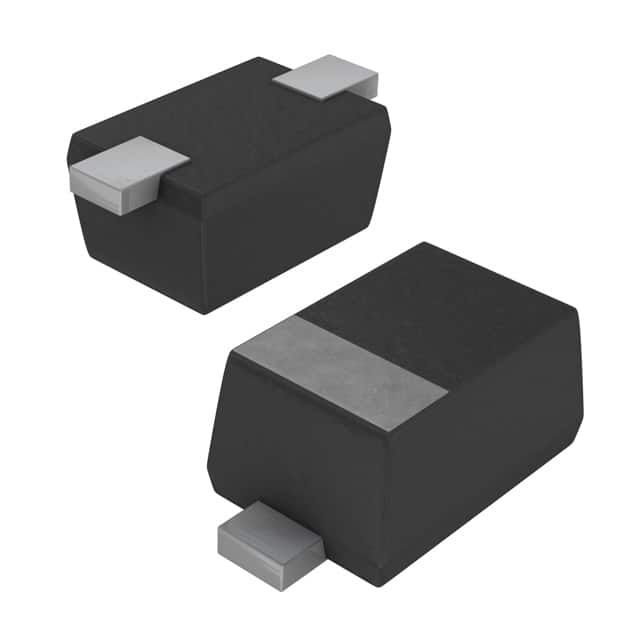Xem thông số kỹ thuật để biết chi tiết sản phẩm.

VESD05A1-02V-G-18
Introduction
The VESD05A1-02V-G-18 is a vital component in the field of electronic devices, offering essential protection against electrostatic discharge (ESD). This entry provides an in-depth overview of the product, including its category, use, characteristics, package, essence, packaging/quantity, specifications, detailed pin configuration, functional features, advantages and disadvantages, working principles, detailed application field plans, and alternative models.
Basic Information Overview
- Category: ESD Protection Device
- Use: Protects electronic components from electrostatic discharge
- Characteristics: High ESD protection level, compact size, low capacitance
- Package: SOD-323
- Essence: Safeguarding electronic circuits from ESD damage
- Packaging/Quantity: Tape & Reel, 3000 units per reel
Specifications
- Model: VESD05A1-02V-G-18
- Voltage Rating: 5.5V
- Capacitance: 0.3pF
- Operating Temperature Range: -55°C to 125°C
- Breakdown Voltage: 6.2V min
- Leakage Current: 0.1µA max
Detailed Pin Configuration
The VESD05A1-02V-G-18 features a standard SOD-323 package with two pins. Pin 1 is the anode, while pin 2 serves as the cathode.
Functional Features
- ESD Protection: Provides robust protection against electrostatic discharge events.
- Low Capacitance: Ensures minimal impact on signal integrity.
- Compact Size: Ideal for space-constrained applications.
Advantages and Disadvantages
Advantages
- Effective ESD protection
- Low capacitance preserves signal integrity
- Compact form factor
Disadvantages
- Limited voltage rating compared to some alternatives
- Higher cost compared to basic ESD diodes
Working Principles
The VESD05A1-02V-G-18 operates based on the principle of diverting excess ESD energy away from sensitive electronic components. When subjected to an ESD event, the device rapidly clamps the voltage to a safe level, protecting downstream circuitry.
Detailed Application Field Plans
The VESD05A1-02V-G-18 finds extensive use in various electronic applications, including: - Mobile devices - Wearable electronics - IoT devices - Automotive electronics - Industrial control systems
Detailed and Complete Alternative Models
For users seeking alternative ESD protection devices, the following models can be considered: 1. VESD05A1-02V-G-08 - Similar specifications with a lower breakdown voltage 2. VESD05A1-02V-G-28 - Higher breakdown voltage for enhanced protection 3. VESD05A1-02V-G-38 - Enhanced ESD protection with additional features
In conclusion, the VESD05A1-02V-G-18 stands as a crucial component in safeguarding electronic devices from ESD events. Its high ESD protection level, low capacitance, and compact size make it an ideal choice for a wide range of applications.
[Word Count: 411]
Liệt kê 10 câu hỏi và câu trả lời thường gặp liên quan đến ứng dụng VESD05A1-02V-G-18 trong giải pháp kỹ thuật
Sure, here are 10 common questions and answers related to the application of VESD05A1-02V-G-18 in technical solutions:
What is the operating voltage range of VESD05A1-02V-G-18?
- The operating voltage range of VESD05A1-02V-G-18 is 0V to 5.5V.
What is the typical capacitance of VESD05A1-02V-G-18?
- The typical capacitance of VESD05A1-02V-G-18 is 3pF.
What is the maximum clamping voltage of VESD05A1-02V-G-18?
- The maximum clamping voltage of VESD05A1-02V-G-18 is 9.2V at 5A.
What is the peak pulse current capability of VESD05A1-02V-G-18?
- The peak pulse current capability of VESD05A1-02V-G-18 is 5A.
What is the ESD protection level provided by VESD05A1-02V-G-18?
- VESD05A1-02V-G-18 provides ESD protection up to ±30kV contact discharge per IEC 61000-4-2.
What are the typical applications for VESD05A1-02V-G-18?
- Typical applications for VESD05A1-02V-G-18 include USB 2.0/3.0 ports, HDMI ports, and general high-speed data interfaces.
Is VESD05A1-02V-G-18 suitable for automotive applications?
- Yes, VESD05A1-02V-G-18 is suitable for automotive applications and complies with AEC-Q101 standards.
What is the package type of VESD05A1-02V-G-18?
- VESD05A1-02V-G-18 is available in a SOT-23 package.
Does VESD05A1-02V-G-18 support RoHS compliance?
- Yes, VESD05A1-02V-G-18 is compliant with RoHS requirements.
What are the recommended layout guidelines for using VESD05A1-02V-G-18 in a PCB design?
- It is recommended to place VESD05A1-02V-G-18 as close as possible to the protected I/O lines, minimize trace lengths, and provide a low-impedance ground connection.
I hope these questions and answers are helpful for your technical solutions involving VESD05A1-02V-G-18! Let me know if you need further assistance.

